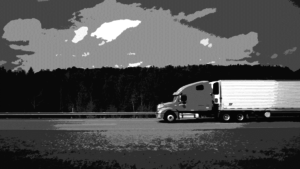Lytx /lɪtɪks/ n. 1. a company saving lives on the road, digitally

Trucking is one of the largest occupations in the United States. And it is becoming less safe. Lytx is working to fix this. Why wait for autonomous trucks when you can save hundreds or thousands of lives today?
 Trucking is among the largest occupations in the U.S. There are ~1.7 million heavy truck drivers domestically. Including drivers of light trucks and buses, this number rises above 3.4 million people. [1] That’s astounding! Truck driving touches 2.5% of those employed in the country – and their families – not to mention the many people who drive along trucks on the highway or walk in front of trucks at cross-walks.
Trucking is among the largest occupations in the U.S. There are ~1.7 million heavy truck drivers domestically. Including drivers of light trucks and buses, this number rises above 3.4 million people. [1] That’s astounding! Truck driving touches 2.5% of those employed in the country – and their families – not to mention the many people who drive along trucks on the highway or walk in front of trucks at cross-walks.
Yet, stats from NHTSA indicate that, in 2014, there were 3,903 people killed and ~111,000 people injured in crashes involving large trucks. [2] In 2015, there were 4,067 fatalities in large truck accidents; this was an increase of over 4%. Across all highway traffic, the rate of fatalities per vehicle-mile-traveled also increased! [3] Truck driving is one of the largest occupations – and it’s becoming less safe for everyone.
In addition to human costs, there are financial costs. A DoT study estimated that the average cost of a truck accident was over $91,000. [4]
How can we fix this?
 While myriad companies are working on the autonomous future of trucking (Daimler, WABCO, and Otto/Uber, etc.), a company in San Diego is using the increasing digitization of trucks to solve these safety problems right now. [5-7] It’s called Lytx (as in ana-“lytics”).
While myriad companies are working on the autonomous future of trucking (Daimler, WABCO, and Otto/Uber, etc.), a company in San Diego is using the increasing digitization of trucks to solve these safety problems right now. [5-7] It’s called Lytx (as in ana-“lytics”).
Lytx operates on the premise that digital technology and analytics can make trucking safer and more efficient – getting shipped goods where they need to go while every trucker, highway user, and pedestrian goes home to their families.
Lytx’s core solution, called DriveCam, is a cellular-enabled video recorder installed near a rear-view mirror in a truck. The video is “two-way” meaning that it has cameras that face both out (i.e., onto the road) and in (i.e., into the cab of the truck). If embedded sensors detect a risky driving event – say, hard braking, sudden acceleration, swerving, or excessive speed – the device captures video. [8] Then the recording is uploaded to a central database where it is scored by Lytx’s algorithms to determine the riskiness of the event. In the unfortunate event of an accident, DriveCam provides a record of what happened – potentially exonerating a trucker who could have otherwise lost their job.
However, no driver – nor Lytx – wants an accident in the first place! To this end, Lytx has created a more comprehensive service called ActiveVision (see below). ActiveVision links DriveCam with a truck’s Engine Control Module and third-party advanced driver assistance systems (so called, ADAS). [9] With more information from sensors throughout the truck, Lytx’s analytical engines have a more complete picture of how a driver operates in different situations. Hard breaking or swerving can, in fact, be good driving depending on the situation. Conversely, other behaviors – such as rolling stops or driving too close to a lane barrier – can be dangerous, but accelerometers alone might not capture them.
 Lytx uses this holistic information to provide immediate in-vehicle alerts (when immediate action is required) and post-drive, video-based coaching. Information from a variety of sources is married with human follow-up to ensure learning and increased safety, going forward.
Lytx uses this holistic information to provide immediate in-vehicle alerts (when immediate action is required) and post-drive, video-based coaching. Information from a variety of sources is married with human follow-up to ensure learning and increased safety, going forward.
Lytx has also developed a machine learning algorithm, called AutoTune, which operates in the background of ActiveVision. AutoTune uses each mile driven by a truck to enhance ActiveVision’s recognition of potentially dangerous driving and minimize the likelihood of false alerts.
Does it work? Yes. The Virginia Tech Transportation Institute estimated that if DriveCam, alone, had been installed on all heavy trucks in the U.S. from 2010 through 2012, it could have saved 801 lives per year and avoided over 39,000 injuries per year. [10] And, this is arguably conservative in that it excludes many different types of accidents.
While concerns about “Big Brother” are a potential threat to Lytx, as Swift Transportation’s (one of the nation’s largest freight trucking companies) President and COO said, “we are not watching the driver; we are watching out for the driver.” [11] Lytx’s product is about driver safety and driver security.
Going forward, Lytx should advance their mission in at least three ways:
First, Management needs to continue educating drivers on the benefits of these systems. Although the product may seem “creepy,” the truck drivers that do their job “the right way” (and don’t text and drive!) should want the opportunity to protect themselves from career-ending lawsuits.
Second, Lytx must continue to be “part of the ecosystem” and integrate with new ADAS technologies. AutoTune’s machine learning gets better with more contextual information about a driver’s behavior.
Finally, Management must have a technology roadmap that negotiates an increasingly boring driver experience. As trucks become more autonomous, drivers will need stimulation to stay “on-call” in the event they need to take control. Gamification could help here.
In February, Chicago-based PE firm GTCR acquired Lytx (reportedly for “more than $500 million!”). [12] They clearly see a lot of potential. I do too. What do you think?
(794 words)
https://www.youtube.com/watch?v=pvmOfKSAD38
[1] Bureau of Labor Statistics, United States Department of Labor, “Occupational Employment Statistics (May 2015),” http://www.bls.gov/oes/, accessed November 2016.
[2] National Highway Traffic Safety Administration, U.S. Department of Transportation, “Traffic Safety Facts: 2014 Data,” https://crashstats.nhtsa.dot.gov/Api/Public/ViewPublication/812279, accessed November 2016.
[3] National Highway Traffic Safety Administration, U.S. Department of Transportation, “2015 Motor Vehicle Crashes: Overview,” https://crashstats.nhtsa.dot.gov/Api/Public/ViewPublication/812318, accessed November 2016.
[4] Federal Motor Carrier Safety Administration, U.S. Department of Transportation, “Unit Costs of Medium and Heavy Truck Crashes, March 2007,” http://ntl.bts.gov/lib/32000/32500/32538/07-034_RP_TruckCosts2007.pdf, accessed November 2016.
[5] “Driving Autonomously Through Nevada,” press release, on Daimler AG website, https://www.daimler.com/innovation/autonomous-driving/freightliner-inspiration-truck.html, accessed November 18, 2016.
[6] “WABCO Reports Further Major Steps Toward Autonomous Driving for Commercial Vehicles; Collaborates With Peloton to Advance Innovative Truck Platooning Solution; Set to Form a Joint Venture for Active Steering,” press release, on WABCO website, http://www.wabco-auto.com/media/media-center/press-releases/press-releases-single-view/news-article/wabco-reports-further-major-steps-toward-autonomous-driving-for-commercial-vehicles-collaborates-wi/, accessed November 2016.
[7] Alex Davies, “Uber’s Self-Driving Truck Makes First Delivery: 50,000 Beers,” Wired, October 25, 2016, https://www.wired.com/2016/10/ubers-self-driving-truck-makes-first-delivery-50000-beers/, accessed November 2016.
[8] “The DriveCam Program FAQ,” press release, on Lytx website, http://info.drivecam.com/rs/lytx/images/Lytx%20ARI%20The%20DriveCam%20Program%20FAQs%200514_0337_5.21.pdf, accessed November 2016.
[9] “Lytx Launches ActiveVision Service, a Revolutionary New System to Tackle the $175B Problem of Distracted and Drowsy Driving,” press release, October 13, 2015, on Lytx website, https://www.lytx.com/en-us/news-events/press-release/lytx-launches-activevision-service-a-revolutiona, accessed November 2016.
[10] Susan Soccolich and Jeffrey S. Hickman, “Potential Reduction in Large Truck and Bus Traffic Fatalities and Injuries Using Lytx’s DriveCam Program,” Virginia Tech Transportation Institute, May 2014, https://www.lytx.com/getattachment/5215bbe9-771a-4996-8d33-de7dd611881f/Lytx-VirginiaTech-Study-LivesSaved.pdf?lang=en-us, accessed November 2016.
[11] David Z. Morris, “There’s pressure in the industry to monitor truck drivers—and drivers aren’t happy,” Fortune, May 26, 2015, http://fortune.com/2015/05/26/driver-facing-truck-cameras/, accessed November 2016.
[12] Seth Clevenger, “Lytx to Be Sold to Private Equity Firm GTCR for $500 Million,” Transport Times, February 18, 2016, http://www.ttnews.com/articles/basetemplate.aspx?storyid=40940, accessed November 2016.



I think so too, Cameron! I’m amazed at how robust and prolific the company is, which I absolutely admire. I think they’ve struck a gold mine. When everyone else is trying hard to add marginal value to an undefined large population, companies like Lytx brings impact by understanding a niche market comprehensively. Moreover, instead of trying to replace truck drivers (or “disrupt the industry”), they innovate to aid and assist humans, which helps the technology gets adopted faster and better.
I’m interested to learn more about their competition in the current space, and what partnerships they’re fostering to protect its spot in the niche market. Also, as much as I like them focusing on current technologies, how are they hedging their risk of driverless trucks in the future?
There are actually a lot of companies trying to break into or expand into this space. As Driver Safety said, there were 4067 fatalities involving large trucks. Each of these fatalities can cost a trucking company about 3 million USD. As you can see, trucking companies are very incentivized to minimize the risk of such collisions, both from a financial and moral standpoint. Besides Lytx both large existing companies such as Cat and small start-ups like comma.ai are trying to break into this space. Some are even trying to use smart phones for fatigue detection(i.e. can you detect when a driver nods off at the wheel). Their biggest obstacle right now is the drivers themselves. Truck drivers do not like the notion of having their every move tracked and watched. Many large transportation companies have issues with drivers unplugging the ADAS and then when the company stops receiving data, claiming the system broke.
Great post! I had the same concern as Alan. My initial reaction is that the truck drivers would not like to have the devices installed in their trucks because they find them invasive and don’t want the device reporting everything that the driver is doing wrong. That is certainly the feeling I had when using my sister’s car, which had the Progressive Snapshot device to monitor driving behavior. Her device monitors hard breaking, and both she and I have found it frustrating. While it did make us more conscious of our breaking habits, it did not make us better drivers, and it was very frustrating anytime we had to break quickly in response to another car’s poor driving. In these cases, it sounds like Lytx’s system would have exonerated the driver. I think more important to truck driving is figuring out how to prevent fatigue on long rides and keep people alert/engaged. Does the company have any plans to offer their product to personal car insurers? Allstate recently filed a patent for cameras and sensors to detect distractions.
What a neat company! I think a solution like this that assists drivers rather than tries to supplant drivers will have a much easier time hitting the main stream — and that’s a great thing. I echo Alan’s concern that driver’s might be more worried about the “Big Brother” impact than we might suspect. After all, it’s my understanding that long-haul drivers view their truck as their home, and I know I certainly wouldn’t like it if there was a camera tracking my every move.
One thing you’d mentioned is that “erratic” driving can actually be the right decision for a truck driver. I wonder how this solution would take into account those types of decisions, rather than just hitting the brake and causing more trouble!